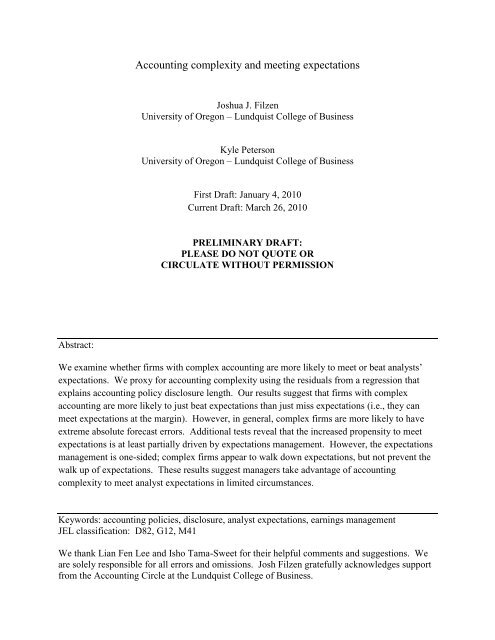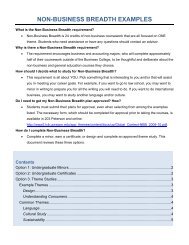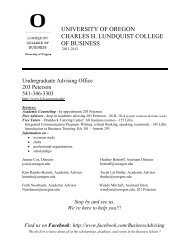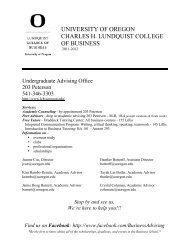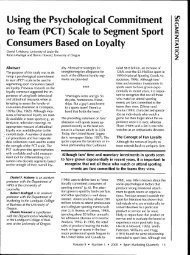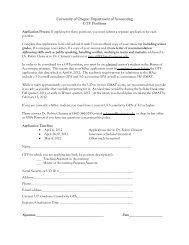The effects of accounting complexity - Lundquist College of ...
The effects of accounting complexity - Lundquist College of ...
The effects of accounting complexity - Lundquist College of ...
Create successful ePaper yourself
Turn your PDF publications into a flip-book with our unique Google optimized e-Paper software.
Abstract:<br />
Accounting <strong>complexity</strong> and meeting expectations<br />
Joshua J. Filzen<br />
University <strong>of</strong> Oregon – <strong>Lundquist</strong> <strong>College</strong> <strong>of</strong> Business<br />
Kyle Peterson<br />
University <strong>of</strong> Oregon – <strong>Lundquist</strong> <strong>College</strong> <strong>of</strong> Business<br />
First Draft: January 4, 2010<br />
Current Draft: March 26, 2010<br />
PRELIMINARY DRAFT:<br />
PLEASE DO NOT QUOTE OR<br />
CIRCULATE WITHOUT PERMISSION<br />
We examine whether firms with complex <strong>accounting</strong> are more likely to meet or beat analysts‘<br />
expectations. We proxy for <strong>accounting</strong> <strong>complexity</strong> using the residuals from a regression that<br />
explains <strong>accounting</strong> policy disclosure length. Our results suggest that firms with complex<br />
<strong>accounting</strong> are more likely to just beat expectations than just miss expectations (i.e., they can<br />
meet expectations at the margin). However, in general, complex firms are more likely to have<br />
extreme absolute forecast errors. Additional tests reveal that the increased propensity to meet<br />
expectations is at least partially driven by expectations management. However, the expectations<br />
management is one-sided; complex firms appear to walk down expectations, but not prevent the<br />
walk up <strong>of</strong> expectations. <strong>The</strong>se results suggest managers take advantage <strong>of</strong> <strong>accounting</strong><br />
<strong>complexity</strong> to meet analyst expectations in limited circumstances.<br />
Keywords: <strong>accounting</strong> policies, disclosure, analyst expectations, earnings management<br />
JEL classification: D82, G12, M41<br />
We thank Lian Fen Lee and Isho Tama-Sweet for their helpful comments and suggestions. We<br />
are solely responsible for all errors and omissions. Josh Filzen gratefully acknowledges support<br />
from the Accounting Circle at the <strong>Lundquist</strong> <strong>College</strong> <strong>of</strong> Business.
1. Introduction<br />
<strong>The</strong> benefits <strong>of</strong> meeting analysts‘ earnings expectations are well documented in the<br />
literature (Dechow and Skinner 2000, Barth, Elliott, and Finn 1999, and Skinner and Sloan<br />
2001). Given these benefits, it is not surprising research also suggests managers manage<br />
earnings to meet or beat analysts‘ expectations (Degeorge, Patel, and Zeckhouser 1999; Payne<br />
and Robb 2000; Abarbanell and Lehavy 2003; Burgstahler and Eames 2006; Matsumoto 2002;<br />
Barton and Simko 2002; Graham, Harvey, and Rajgopal 2005). Prior research also suggests that<br />
in specific settings where <strong>accounting</strong> is more complex that firms manage their earnings. Picconi<br />
(2006) and Bergstresser, Desai, and Rauh (2006) find that investors and analysts do not<br />
understand the effect <strong>of</strong> changes in pension plan parameters on future earnings and managers<br />
exploit this limited understanding to manage earnings. We attempt to understand the effect <strong>of</strong><br />
<strong>accounting</strong> <strong>complexity</strong> on meeting expectations in a broader context. Specifically, we examine<br />
whether <strong>accounting</strong> <strong>complexity</strong> makes it more likely for managers to meet analyst expectations.<br />
We also test whether <strong>accounting</strong> <strong>complexity</strong> is associated with less extreme earnings forecasts,<br />
consistent with earnings smoothing. Finally, we examine whether firms with complex<br />
<strong>accounting</strong> are more likely to meet expectations using expectations management.<br />
We view <strong>accounting</strong> <strong>complexity</strong> similar to Peterson (2009b) and SEC (2008) in that<br />
<strong>complexity</strong> increases uncertainty related to <strong>accounting</strong> information for both preparers and<br />
financial statement users. We conjecture that <strong>accounting</strong> <strong>complexity</strong> increases the probability <strong>of</strong><br />
meeting expectations due to two <strong>effects</strong>. First, firms with complex <strong>accounting</strong> require more<br />
subjective judgment by managers, increasing their ability to manage earnings without detection.<br />
Second, prior literature also suggests <strong>complexity</strong> creates information asymmetry between<br />
1
managers and investors or analysts, making it easier for managers to manage analysts/investors<br />
expectations (Peterson, 2009a; Li, 2008; Miller, 2008).<br />
Our proxy for complex <strong>accounting</strong> is the abnormal length <strong>of</strong> <strong>accounting</strong> policy<br />
disclosures in the 10-K. Abnormal length is measured using the residuals from a regression <strong>of</strong><br />
the number <strong>of</strong> words in the <strong>accounting</strong> policy disclosures on explanatory variables that include<br />
year and industry fixed <strong>effects</strong>, other financial indicators, and the number <strong>of</strong> business segments.<br />
Peterson (2009a) finds that abnormally long <strong>accounting</strong> policies are associated with more<br />
dispersed beliefs <strong>of</strong> analysts and investors.<br />
Our sample is 83,837 firm-quarters from 1994-2008 with necessary data on Compustat,<br />
CRSP, and IBES for which we are also able to extract <strong>accounting</strong> policies from 10-K filings<br />
from the SEC Edgar database. We hypothesize that <strong>accounting</strong> <strong>complexity</strong> is positively<br />
associated with the propensity to meet or beat analyst expectations. We first estimate a logistic<br />
regression <strong>of</strong> firms with forecast errors close to zero to test whether <strong>accounting</strong> <strong>complexity</strong> is<br />
associated with meeting expectations. Our results are consistent with firms with complex<br />
<strong>accounting</strong> being more likely to report small positive forecast errors than small negative errors,<br />
suggesting <strong>complexity</strong> gives managers an edge in meeting expectations.<br />
We also examine the effect <strong>of</strong> <strong>accounting</strong> <strong>complexity</strong> on forecast errors more broadly to<br />
better understand if managers <strong>of</strong> complex firms are also able to reduce the incidence <strong>of</strong> extreme<br />
forecast errors. Results consistent with this would provide evidence that managers are able to<br />
smooth forecast errors, not just beat expectations at the margin. We do not make any strong<br />
predictions about this effect because <strong>of</strong> two countervailing <strong>effects</strong>. On the one hand, managers<br />
may be able to manage earnings or expectations sufficient to allow smoothing across time. On<br />
the other hand, Peterson (2009a) finds that abnormal <strong>accounting</strong> length is positively associated<br />
2
with analyst forecast error and dispersion because it is more difficult to forecast for complex<br />
firms. This increased forecasting difficulty may make it more difficult for managers to engage in<br />
smoothing, and at the same time provide managers with incentives to make their earnings more<br />
predictable (smoother). We separate firm quarters into seven bins based on the size <strong>of</strong> the<br />
absolute forecast error. We examine the distributional properties <strong>of</strong> forecast errors in a<br />
univariate and multivariate setting and find that firms with complex <strong>accounting</strong> are more likely<br />
to have extreme forecast errors, which is inconsistent with smoothing but consistent with the<br />
findings in Peterson (2009a).<br />
Because meeting expectations could be the result <strong>of</strong> earnings management or<br />
expectations management, we also test whether complex <strong>accounting</strong> is associated with<br />
expectations management. Specifically, we perform two sets <strong>of</strong> tests to answer this question.<br />
First, we re-estimate the logit regression from our first hypothesis using the first forecast <strong>of</strong> the<br />
period (as opposed to the most recent forecast). We expect that if expectations management is<br />
present our results will weaken when using the first forecast <strong>of</strong> the period rather than the last.<br />
While the coefficient is positive and significant on our proxy for <strong>accounting</strong> <strong>complexity</strong> (p-value<br />
less than 0.01) when using the most recent forecast for the quarter, it is insignificant when using<br />
the first forecast <strong>of</strong> the quarter (p-value <strong>of</strong> 0.715). <strong>The</strong>se results indicate that the expectations for<br />
complex firms changed during the quarter to make it more likely they beat expectations. 1 We<br />
also test two other logistic regressions that provide evidence <strong>of</strong> expectations management. <strong>The</strong><br />
first tests whether the firm beat expectations, but would not have done so based on the first<br />
forecast in the quarter, which would be consistent with expectations management (and therefore<br />
1 While we cannot say definitively that the firm engaged in expectations management, the trend <strong>of</strong> the forecasts<br />
over the period suggest analysts did change their expectations for complex firms that allowed them to beat<br />
expectations.<br />
3
expect a positive coefficient on <strong>complexity</strong>). <strong>The</strong> second tests whether the firm missed<br />
expectations, but would have beat based on the first forecast in the quarter, which would be<br />
inconsistent with expectations management (and therefore we expect a negative coefficient on<br />
<strong>complexity</strong>). <strong>The</strong> first test results are consistent with complex firms exhibiting expectations<br />
management. <strong>The</strong> coefficient from the second test (for those firms that missed the forecast) is<br />
signed as predicted, but is not statistically different from zero. <strong>The</strong>se results suggest complex<br />
firms are able to walk down forecasts to meet expectations, but not prevent the walk up <strong>of</strong><br />
expectations.<br />
Our research contributes to the understanding <strong>of</strong> how firms meet analyst expectations.<br />
Prior research suggests that incentives (e.g., compensation and maintaining streaks) and<br />
constraints (e.g., balance sheet) influence whether firms are able to meet expectations. <strong>The</strong><br />
evidence presented here suggests the <strong>complexity</strong> <strong>of</strong> the <strong>accounting</strong> environment also contributes<br />
to managers‘ ability to meet expectations. This ability to meet expectations appears to be<br />
partially driven by expectations management. In addition, our research provides some large<br />
sample empirical evidence to support the beliefs and the anecdotes that arise from events like<br />
those associated with Enron and Fannie Mae that investors may be skeptical about the earnings<br />
<strong>of</strong> complex firms (Chanos, 2006; Greenberg, 2008; Miller and Bahnson, 2002). 2 Finally, by<br />
examining <strong>accounting</strong> <strong>complexity</strong> using the complete set <strong>of</strong> <strong>accounting</strong> policies, this research<br />
contributes to the call by Fields, Lys and Vincent (2001) to examine the <strong>effects</strong> <strong>of</strong> <strong>accounting</strong><br />
choice more broadly.<br />
2 Miller and Bahnson (2002) identify the following statement made by Warren Buffet. ―If I pick up an annual<br />
report and I can‘t understand a footnote, I probably won‘t—no, I won‘t—invest in that company because I know that<br />
they don‘t want me to understand it.‖<br />
4
<strong>The</strong> next section develops the hypotheses, including a discussion <strong>of</strong> prior literature.<br />
Section 3 discusses the data and research design. Section 4 presents the results <strong>of</strong> the tests, and<br />
Section 5 concludes.<br />
2. Prior Literature and Hypotheses<br />
2.1 Meeting analyst expectations<br />
Our proxy for earnings management is a firm‘s propensity to meet or beat analysts‘<br />
expectations. Bartov, Givoly, and Hayn (2002) and Kasznik and McNichols (2002) document a<br />
market reward for meeting analysts‘ forecasts, while Skinner and Sloan (2002) document a larger<br />
response to negative earnings surprises than to positive earnings surprises. <strong>The</strong>se studies provide<br />
evidence <strong>of</strong> a motivation for managers to meet or beat analysts‘ expectations. In addition,<br />
Degeorge et al. (1999) use distributional analysis to provide evidence that firms engage in<br />
earnings management to meet or beat analysts‘ expectations. Finally, Brown and Caylor (2005)<br />
explain that in the period <strong>of</strong> 1996-2002 meeting or beating analyst expectations (MBE) is the<br />
most important threshold for managers and suggest researchers focus on MBE <strong>of</strong> quarterly<br />
earnings when examining earnings management in more recent periods.<br />
Besides the findings from prior literature discussed above, there are other advantages to<br />
using MBE in our tests as opposed to examining discretionary accruals. Healy and Wahlen<br />
(1999) explain that an output measure like MBE allows researchers to capture all forms <strong>of</strong><br />
earnings management. McNichols (2003) argues that no single model (e.g. an accrual model)<br />
can capture the heterogeneous discretion that managers have when deciding how to manage<br />
earnings. Also, there is no consensus in the literature that there is a link between discretionary<br />
5
accruals and MBE. Graham et al. (2005) survey CFOs and find that although managers are<br />
concerned with meeting analyst expectations, they are more likely to decrease discretionary<br />
spending and delay projects than manage accruals. Although Matsumoto (2002) finds some<br />
limited support for the use <strong>of</strong> discretionary accruals to MBE, Athanasakou, Strong, and Walker<br />
(2009) find no evidence <strong>of</strong> the use <strong>of</strong> accruals management to MBE in a sample <strong>of</strong> UK firms.<br />
For these reasons, we focus our research on the MBE outcome-based approach to provide<br />
inferences <strong>of</strong> earnings management.<br />
2.2 Hypotheses<br />
Peterson (2009b) defines <strong>accounting</strong> <strong>complexity</strong> as ―uncertainty related to the mapping <strong>of</strong><br />
transactions or potential transactions and standards into the financial statements.‖ <strong>The</strong> SEC‘s<br />
Committee on Improvements to Financial Reporting (ACIFR) defines <strong>complexity</strong> for preparers<br />
as the difficulty ―to properly apply [U.S. GAAP] and communicate the economic substance <strong>of</strong> a<br />
transaction‖ and for investors as the difficulty in understanding the ―economic substance <strong>of</strong> a<br />
transaction or event and the overall financial position and results <strong>of</strong> a company‖ (SEC, 2008).<br />
We conjecture that <strong>accounting</strong> <strong>complexity</strong> should be positively associated with managers‘<br />
ability to meet or beat analyst expectations. <strong>The</strong> basis for this expectation rests on the following<br />
two reasons, which are supported by a small set <strong>of</strong> studies examining <strong>accounting</strong> <strong>complexity</strong>.<br />
First, firms with complex <strong>accounting</strong> are assumed to have more opportunities to manage earnings<br />
due to additional subjective accrual estimates. 3 This is consistent with the research by Picconi<br />
(2006) and Bergstresser et al. (2006), who find that investors and analysts do not understand the<br />
3 Subjective estimates could be thought <strong>of</strong> as necessary to induce uncertainty, which is an essential attribute <strong>of</strong><br />
complex <strong>accounting</strong>. For example, the least subjective account on the balance sheet is cash, which would also be<br />
considered low <strong>complexity</strong>.<br />
6
effect <strong>of</strong> changes in pension plan parameters on future earnings. <strong>The</strong>y find managers exploit this<br />
<strong>complexity</strong> by increasing rates <strong>of</strong> return assumptions on pension assets: (1) to <strong>of</strong>fset the effect <strong>of</strong><br />
anticipated future bad news, (2) when the assumptions have a greater impact on earnings, and (3)<br />
when managers are attempting to acquire other firms or exercise stock options. This research on<br />
pensions is similar to other earnings management papers that examine specific areas <strong>of</strong><br />
<strong>accounting</strong> and find evidence that suggest earnings management (Fields, et al., 2001 and Ronen<br />
and Yaari, 2008).<br />
Second, in light <strong>of</strong> prior research, we also view <strong>accounting</strong> <strong>complexity</strong> as potentially<br />
increasing the information asymmetry between managers and financial statement users. This<br />
information asymmetry makes it easier for managers to manage analysts/investors expectations,<br />
which increases the probability that the firm will meet those expectations. 4 Research supports<br />
this view <strong>of</strong> <strong>complexity</strong> increasing information asymmetry. For example, Peterson (2009a) finds<br />
that long abnormal <strong>accounting</strong> policies are associated with increased trading volume and return<br />
volatility around firms‘ earnings announcement. In a related setting, both Li (2008) and Miller<br />
(2008) argue that longer 10-K filings make it more difficult for investors to understand and<br />
interpret the financial information contained in the 10-K. Li (2008) shows that managers use<br />
longer disclosures to mask poor future performance. 5 Miller (2008) documents that firms with<br />
longer 10-K filings are associated with fewer trades by, and more disagreement among, smaller<br />
investors. We conjecture that these two <strong>effects</strong>, subjective accrual estimates and managing<br />
4 Our tests, discussed in Section 3, are not specific in identifying the mechanisms used to manage expectations.<br />
<strong>The</strong>se mechanisms could include management forecasts (Kasznik, 1999 and Burgstahler and Eames, 2006),<br />
conference calls (Cotter, Tuna, and Wysocki, 2006), or other disclosures.<br />
5 Li (2008) uses both a measure <strong>of</strong> annual report length and the Fog Index to measure the difficulty users have in<br />
reading financial statements. We do not use the Fog Index in this study because <strong>accounting</strong> policy disclosures are<br />
more technical in nature relative to the whole annual report, reducing the index‘s ability to capture cross-sectional<br />
variation for these disclosures across firms.<br />
7
expectations, will be especially prevalent at the margin (i.e., firms close to analysts‘<br />
expectations).<br />
H1: Firms with more complex <strong>accounting</strong> are more likely to meet or beat analysts‘<br />
expectations at the margin than firms with less complex <strong>accounting</strong>.<br />
While H1 predicts managers <strong>of</strong> complex firms are better able to meet expectations at the<br />
margin, we also examine whether the ability <strong>of</strong> complex firms to meet expectations applies more<br />
broadly. Complexity may be such a valuable tool that it allows managers to string together very<br />
consistent streams <strong>of</strong> meeting expectations. 6 However, in this broader context, managers <strong>of</strong><br />
complex firms face a countervailing effect on their desire and ability to smooth. Peterson<br />
(2009a) finds that complex firms have earnings forecasts with higher dispersion and error,<br />
suggesting it may be more difficult for analysts to forecast earnings for complex firms, and<br />
subverting the manager‘s ability to meet expectations generally. Consistent with the approach <strong>of</strong><br />
Abarbanell and Lehavy (2003), we examine the association between <strong>accounting</strong> <strong>complexity</strong> and<br />
the magnitude <strong>of</strong> forecast errors. Because we cannot predict ex ante which force (the ability to<br />
smooth vs. the difficulty in forecasting) is stronger, our hypothesis is stated as a conditional<br />
prediction:<br />
H2: If managers <strong>of</strong> complex firms engage in smoothing, those firms should have less<br />
extreme forecast errors than firms with less complex <strong>accounting</strong>.<br />
Finally, we examine whether the ability <strong>of</strong> complex firms to meet analyst expectations is<br />
a result <strong>of</strong> expectations management. Bartov et al. (2002) find a premium to meeting or beating<br />
6 Our question here is similar in principle to research that suggests managers engage in earnings smoothing.<br />
Gaver, Gaver, and Austin (1995) document a relationship between discretionary accruals and bonus plans that is<br />
more consistent with income smoothing. DeFond and Park (1997) also provide evidence that firms smooth<br />
earnings; however, the results in Elgers, Pfeiffer Jr., and Porter (2003) suggest smoothing is not present when using<br />
randomization tests. Graham et al. (2005) survey CFOs and find that CFOs are both interested in meeting analyst<br />
expectations and having smooth earnings.<br />
8
expectations even when it is the result <strong>of</strong> expectations management. Richardson, Teoh, and<br />
Wysocki (2004) find the walk-down <strong>of</strong> expectations is more pronounced when managers are<br />
selling stock. We follow this prior research by examining whether complex firms are more<br />
likely to have expectation paths that suggest expectations were managed. Because <strong>of</strong> increased<br />
information asymmetry resulting from <strong>accounting</strong> <strong>complexity</strong> discussed above, we believe firms<br />
with more complex <strong>accounting</strong> can more easily manage expectations. <strong>The</strong>refore, we predict the<br />
following:<br />
H3: Firms with more complex <strong>accounting</strong> are more likely to have forecast paths that are<br />
consistent with expectations management than less complex firms.<br />
3. Research Design<br />
3.1 Measuring <strong>accounting</strong> <strong>complexity</strong><br />
We follow Peterson (2009a) to proxy for <strong>accounting</strong> <strong>complexity</strong> by estimating abnormal<br />
<strong>accounting</strong> policy disclosure length (AB ACC POL) as discussed below. As with any proxy, and<br />
especially a new one, we discuss a few issues with measurement <strong>of</strong> this construct.<br />
<strong>The</strong>oretical (e.g., Diamond, 1985; Diamond and Verrecchia, 1991; Barry and Brown,<br />
1985; see also Botosan, 1997) and empirical (see Botosan, 1997; Lang and Lundholm, 1996)<br />
research suggests that additional disclosure is processed by the market and reduces information<br />
asymmetry and cost <strong>of</strong> capital (i.e., additional disclosure is better). Because our proxy for<br />
<strong>accounting</strong> <strong>complexity</strong> is really a measure <strong>of</strong> abnormal disclosure length, our prediction that<br />
<strong>accounting</strong> policy disclosure length increases uncertainty appears to contradict this widely held<br />
result. 7 We make two points regarding this seeming contradiction. First, our measure could<br />
7 Botosan (1997) also makes the claim that disclosure quality is difficult to measure separate from disclosure<br />
quanitity (or the level <strong>of</strong> disclosure). However, researchers have generally assumed that quality and quantity are<br />
9
capture both <strong>complexity</strong> and more accurate, quality disclosure at the same time. Abnormally<br />
long <strong>accounting</strong> policy disclosures could be high quality disclosures about complex transactions<br />
that would still lead to our hypotheses. This idea was articulated by John Dingell, a U.S.<br />
Congressman, in the following statement about Enron in 2001: ―What we are looking at here is<br />
an example <strong>of</strong> superbly complex financial reports. <strong>The</strong>y didn‘t have to lie. All they had to do<br />
was obfuscate it with sheer <strong>complexity</strong>‖ (McLean, 2001). Second, we rely on prior empirical<br />
studies that suggest disclosure length may not always have favorable <strong>effects</strong> on the information<br />
environment (Li, 2008; Peterson, 2009a; Miller, 2009).<br />
Our measurement <strong>of</strong> abnormal <strong>accounting</strong> policy disclosure length (AB ACC POL) is<br />
consistent with Peterson (2009a). This measure is the residuals from a regression <strong>of</strong> the log<br />
number <strong>of</strong> words <strong>of</strong> the <strong>accounting</strong> policies disclosure on explanatory variables described in<br />
equation (1). We obtain <strong>accounting</strong> policy disclosures from 10-K filings from Edgar using the<br />
Python programming language. See Section 4.1 for more detail about this process.<br />
LOG(<br />
ACC POL LEN )<br />
it<br />
� �1<br />
� �2BTM<br />
it �1 � �3LOG(<br />
ASSETS)<br />
it �1<br />
� �4LOG(<br />
SEG)<br />
it �1<br />
���<br />
FinancialIndicators<br />
� ��Year<br />
� ��<br />
Industry � �<br />
where ACC POL LEN is the number <strong>of</strong> words counted from the <strong>accounting</strong> policy disclosure<br />
section <strong>of</strong> the firm‘s 10-K. BTM is the book-to-market ratio <strong>of</strong> the firm at the beginning <strong>of</strong> the<br />
year. LOG(ASSETS) is the natural logarithm <strong>of</strong> total assets <strong>of</strong> the firm at the beginning <strong>of</strong> the<br />
year. LOG(SEG) is the natural logarithm <strong>of</strong> the number <strong>of</strong> operating segments for the firm<br />
measured at the beginning <strong>of</strong> the year. Below is a list <strong>of</strong> the financial indicator variables<br />
positively related. While distinguishing between quality and quantity might be an (unattainable) empirical ideal,<br />
relying upon a disclosure quantity proxy (as in this paper) still sheds light on our understanding <strong>of</strong> the <strong>effects</strong> <strong>of</strong> the<br />
quantity <strong>of</strong> disclosure.<br />
10<br />
it<br />
(1)
included in the regression above that would normally require disclosure in the <strong>accounting</strong> policy<br />
section: 8<br />
Variable Name Description<br />
Compustat Data<br />
Item Name<br />
R&D Research and Development xrd<br />
DEFERRED REVENUE Deferred Revenue drc or drlt<br />
INTANGIBLES Intangibles or Goodwill gdwl or intan<br />
MINORITY INT Minority Interest mib or mii<br />
FCURRENCY Foreign Currency Translations cicurr<br />
CAPITAL LEASE Capital Lease dclo<br />
PENSION Pension pnca<br />
STOCK COMP Stock Compensation stkco<br />
DISC OPS Discontinued Operations do<br />
ACQUISITIONS Acquisitions aqc<br />
CAPITALIZED INTEREST Capitalized Interest intc<br />
DERIVATIVES Derivatives cidergl<br />
Finally, we include industry and year indicators to capture industry and time trends in<br />
<strong>accounting</strong> policy disclosures. <strong>The</strong> results <strong>of</strong> these regressions are untabulated, but are<br />
consistent with those presented in Peterson (2009a). <strong>The</strong> model provides significant explanation<br />
<strong>of</strong> the length <strong>of</strong> the <strong>accounting</strong> policy disclosures with an R 2 <strong>of</strong> 0.579.<br />
8 One criticism <strong>of</strong> including the financial indicator controls may be that we are controlling for some portion <strong>of</strong><br />
<strong>accounting</strong> <strong>complexity</strong> in this measure. We note that we find consistent results with those presented in the paper<br />
when using a mean adjusted measure by industry-year.<br />
11
3.2 Tests<br />
Our main dependent variables <strong>of</strong> interest are all calculated using analyst forecast error<br />
(FCSTERR), which is calculated as:<br />
FCSTERRit = Actual IBES EPSit – Mean EPS Forecastit (2)<br />
We obtain analyst estimates from the IBES Summary History – Unadjusted statistics file<br />
and actual EPS numbers from the IBES Actuals file. We adjust for stock splits with the<br />
approach suggested by Robinson and Glushkov (2006) which utilizes the CRSP cumulative<br />
adjustment split factors from the daily file. <strong>The</strong> EPS forecast used is the last consensus forecast<br />
<strong>of</strong> the quarter before the earnings announcement date.<br />
3.2.1 Tests <strong>of</strong> H1<br />
Our first test examines whether complex firms are able to meet expectations at the<br />
margin. <strong>The</strong>refore, we test a logit model where the dependent variable (Miss_Beat) is one if 0 �<br />
FCSTERRit < 0.02 and zero if -.02 � FCSTERRit < 0.<br />
<strong>The</strong> classification <strong>of</strong> just meeting or beating based on forecast error is not measured<br />
consistently in prior literature. Some studies (Prawitt et al. 2009; McAnally, Srivastava, and<br />
Weaver 2009) use scaled forecast error, while others use cents (Athanasakou et al. 2009; Cheng<br />
and Warfield 2005; Frankel, Johnson, and Nelson 2002; Yu 2008). We use two cents as our<br />
designation <strong>of</strong> being close to forecast 9 ; however, our results are somewhat sensitive to this<br />
particular categorization. Scaling forecast error by price, which is common in the literature, with<br />
9 In untabulated tests, we exclude 0.02 in the dependent variable to ensure the bins for beating and missing are<br />
equally sized. <strong>The</strong> interval then becomes: Miss_Beatit = 1 if 0 � FCSTERRit < .02. This does not affect the results<br />
presented in the tables.<br />
12
��<br />
just beating/missing at 0.001, obtains consistent results. However, varying the interval based on<br />
cents provides mixed results. Using an interval -.02≤FCSTERR≤.01 provides consistent results,<br />
but using -.01≤FCSTERR≤.01 obtains insignificant results for H1. We believe that a slightly<br />
larger interval (2 cents versus 1 cent) better captures the incentives and abilities <strong>of</strong> managers to<br />
meet expectations when they are close to those expectations. 10 To test H1 we run the following<br />
logit regression:<br />
P(Miss_ Beat it ) � f (� 1�� 2ABACC POL it � �� 3�20Controls � � it ) (3)<br />
Miss_Beat and AB ACC POL were described above. We include a variety <strong>of</strong> control<br />
variables that have been shown in prior literature to be correlated with meeting or beating analyst<br />
expectations. We include controls for institutional ownership, implicit claims, value relevance <strong>of</strong><br />
earnings, growth, size, and changes in earnings (Matsumoto, 2002). In addition, we include<br />
variables to control for previous patterns <strong>of</strong> meeting or beating expectations (Barton and Simko,<br />
2002), uncertainty in the forecasting environment (Matsumoto, 2002; Cheng and Warfield,<br />
2005), leverage (Prawitt et al., 2009), number <strong>of</strong> business segments (Prawitt et al., 2009), cash<br />
flow volatility (Prawitt et al., 2009), outstanding shares (Cheng and Warfield, 2005), auditor<br />
qualities (Frankel et al. 2002), levels <strong>of</strong> operating cash flows (Frankel et al. 2002), net operating<br />
assets (Cheng and Warfield, 2005), and analyst following (Cheng and Warfield, 2005). See<br />
Appendix A for a detailed list <strong>of</strong> control variables. 11<br />
10 In studies that use cents, the interval for establishing ―just beat‖ vs. ―just miss‖ has not been consistently<br />
measured. Athanasakou et al. (2009) use the interval -£.02≤FCSTERR
3.2.2 Tests <strong>of</strong> H2<br />
Our tests <strong>of</strong> H2 require a more complete examination <strong>of</strong> the distribution <strong>of</strong> forecast errors<br />
than our test <strong>of</strong> H1. First, we create quintile portfolios <strong>of</strong> firms according to AB ACC POL with<br />
quintile five including the firms with highest AB ACC POL. Consistent with Abarbanell and<br />
Lehavy (2003), for each quintile, we group forecast errors into increasingly larger and non-<br />
overlapping symmetric intervals moving out from zero forecast errors. For example, the forecast<br />
error range <strong>of</strong> [-0.01, 0) & (0, 0.01] includes all forecast errors that are greater than or equal to -<br />
0.01 and (strictly) less than zero and observations that are greater than zero and less than or equal<br />
to 0.01. We have eight total bins as follows:<br />
BINit = 0 if FCSTERRit = 0<br />
BINit = 1 if FCSTERRit = [-.01, 0) & (0, .01]<br />
BINit = 2 if FCSTERRit = [-.02, -.01) & (.01, .02]<br />
BINit = 3 if FCSTERRit = [-.03, -.02) & (.02, .03]<br />
BINit = 4 if FCSTERRit = [-.04, -.03) & (.03, .04]<br />
BINit = 5 if FCSTERRit = [-.05, -.04) & (.04, .05]<br />
BINit = 6 if FCSTERRit = [-.1, -.05) & (.05, .1]<br />
BINit = 7 if FCSTERRit = [Min, -.1) & (.1, Max]<br />
To determine whether the distribution <strong>of</strong> forecast errors differs across AB ACC POL quintile, we<br />
employ the Kolmogorov-Smirnov equality-<strong>of</strong>-distributions test (Conover, 1971; Smirnov, 1939).<br />
<strong>The</strong> test measures whether the distribution functions associated with two populations (as inferred<br />
by two samples) differ significantly. It tests for more generic differences between the two<br />
distribution functions, not only means or medians (Conover, 1971). Specifically, the test statistic<br />
is the maximum absolute difference between the two samples‘ cumulative distribution functions.<br />
them from this model. However, consistent with our predictions, the inclusion <strong>of</strong> industry and year <strong>effects</strong> in this<br />
model does not affect the results.<br />
14
In addition to the Kolmogorov-Smirnov test for H2, we also estimate a multinomial logit<br />
model to validate the results in a multivariate framework. We use the same variable, BIN, as the<br />
multinomial dependent variable in our model as described in (4).<br />
P BIN ) � f ( � ��<br />
AB ACC POL ���<br />
� Controls ��<br />
)<br />
(4)<br />
( it 1 2<br />
it 3 20<br />
it<br />
Control variables in this model are the same as the ones we use to test H1. We utilize the most<br />
extreme forecast error bin (BIN=7) as the base outcome for the model. <strong>The</strong>refore, a negative<br />
coefficient for β2 would be consistent with <strong>accounting</strong> <strong>complexity</strong> increasing the probability <strong>of</strong><br />
extreme forecast errors, whereas a positive coefficient would suggest managers <strong>of</strong> complex firms<br />
can meet expectations consistently.<br />
3.2.3 Tests <strong>of</strong> H3<br />
We perform two tests to determine whether <strong>accounting</strong> <strong>complexity</strong> is associated with<br />
expectations management (test <strong>of</strong> H3). First, we perform a test similar to one in Bartov et al.<br />
(2002). We first run a logistic regression <strong>of</strong> firms that just beat and just missed expectations<br />
(firms between -0.02 and 0.02 forecast error) using the most recent, or last, forecast error. This<br />
regression is the same regression to test H1. We then re-estimate the regression, but measure the<br />
dependent variable using the first consensus forecast <strong>of</strong> the quarter. If the coefficient using the<br />
last forecast is positive and significant and the coefficient using the first forecast is negative or<br />
insignificant, the results would be consistent with expectations management. Any other findings<br />
would be inconsistent with expectations management. <strong>The</strong> controls are exactly the same as in<br />
(3).<br />
15
Our second set <strong>of</strong> tests also requires estimating logistic regressions. We use two<br />
dependent variables that provide evidence <strong>of</strong> managing expectations. <strong>The</strong> first dependent<br />
variable is measured only for those firms that met or beat the analysts‘ most recent forecast. <strong>The</strong><br />
dependent variable is one if the firm would have missed the forecast using the first forecast <strong>of</strong><br />
the quarter and zero otherwise (MET_EXPMGMT). A dependent variable <strong>of</strong> one is consistent<br />
with expectations management. Our second dependent variable is measured only for those firms<br />
that missed the analysts‘ most recent forecast. <strong>The</strong> dependent variable is one if the firm would<br />
have met or beat the forecast using the first forecast <strong>of</strong> the quarter and zero otherwise<br />
(MISS_EXPMGMT). A dependent variable <strong>of</strong> one in this case is inconsistent with expectations<br />
management because the change in the forecast caused the firm to miss the forecast. Using these<br />
dependent variables, we estimate the following regression:<br />
P(EXPMGMT it )� f(� 1 �� 2 ABACCPOL it ��� 3�20 Controls�� it ) (5)<br />
We include the same control variables as in the multinomial logit regression to control for<br />
��<br />
incentives to manage expectations. Positive (negative) coefficients on AB ACC POL for<br />
MET_EXPMGMT (MISS_EXPMGMT) would be evidence consistent with H3.<br />
4. Sample and Results<br />
4.1 Sample<br />
Using the Python programming language, we collect all available 10-K and 10-K405<br />
filings from Edgar for the years 1994-2008. We then perform a search <strong>of</strong> these 10-Ks using the<br />
Python programming language to obtain the <strong>accounting</strong> policies section <strong>of</strong> the notes to the<br />
financial statements. See Peterson (2009a) for a more detailed description <strong>of</strong> this process. We<br />
are able to collect 60,180 annual <strong>accounting</strong> policy length observations. Since we are interested<br />
16
in the likelihood <strong>of</strong> meeting or beating analyst quarterly expectations, we assume that the<br />
<strong>accounting</strong> policies reported in the 10-Ks are in effect for the entire year. In order to test our<br />
hypotheses, we obtain quarterly financial data from COMPUSTAT Xpressfeed quarterly files.<br />
Necessary annual financial data come from the COMPUSTAT Xpressfeed annual files. We<br />
obtained segment data from the COMPUSTAT legacy files. Institutional ownership data was<br />
obtained from Thompson Reuters. Analyst forecast data was obtained from IBES. See Table 1<br />
Panel A for a description <strong>of</strong> the sample.<br />
Panel B <strong>of</strong> Table 1 gives the frequency <strong>of</strong> the sample by year. <strong>The</strong> sample has relatively<br />
even coverage across the years except for 1994 and 1995 because coverage <strong>of</strong> 10-Ks on the<br />
Edgar database is sparse in those years. Panel C lists the sample by industry relative to a<br />
benchmark <strong>of</strong> firms that have data on Compustat, CRSP, and IBES. Industry classification is the<br />
30 industry classification from Fama and French (1997). <strong>The</strong> sample is slightly over-weighted in<br />
Healthcare, Personal and Business Services, and Business Equipment and underweighted in the<br />
Banking, Insurance, Real Estate, Trading industry relative to the benchmark sample; otherwise,<br />
the samples appear comparable to firms in the intersection <strong>of</strong> Compustat/CRSP/IBES.<br />
4.2 Descriptive Statistics<br />
Table 2 presents univariate statistics for all variables included in equation (3). Note that<br />
the distribution <strong>of</strong> Miss_Beat in our sample is consistent with patterns described in Burgstahler<br />
and Dichev (1997) since there is a disproportionate number <strong>of</strong> observations ―just beating‖ over<br />
―just missing‖. Also, as expected, the mean <strong>of</strong> AB ACC POL is zero because it is the residual <strong>of</strong><br />
a regression that includes an intercept. Also, the mean <strong>of</strong> FCSTERR is 0.02, which is consistent<br />
with the average firm beating expectations. We also note the mean number <strong>of</strong> consecutive<br />
17
quarters the firm has beat expectations is 3.84 and the average number <strong>of</strong> analyst estimates is<br />
7.19, suggesting that many <strong>of</strong> the firms in our sample have relatively high analyst coverage.<br />
4.3 Results <strong>of</strong> Tests <strong>of</strong> H1<br />
Table 3 presents the results <strong>of</strong> the logit regression model presented in equation (3).<br />
Supporting H1, the coefficient on AB ACC POL is positive (0.1072) and significant (p-<br />
value=0.004). This result is consistent with firms with greater <strong>accounting</strong> <strong>complexity</strong> having a<br />
higher propensity to ―just beat‖ (Miss_Beat=1) than to ―just miss‖ (Miss_Beat=0) analyst<br />
expectations.<br />
Table 3 also presents the coefficients for the control variables included in the regression.<br />
Most control variables included are statistically significant, which underscores their importance<br />
in explaining the other incentives and characteristics that cause or allow firms to meet or beat<br />
analysts‘ expectations. Consistent with prior research we find positive coefficients on STREAK,<br />
INSTPERC, LOGMVE, CHGEARN, LEVERAGE, and NUMEST indicating their positive<br />
influence on just meeting or beating expectations over just missing expectations.<br />
We also examine marginal <strong>effects</strong> to address the economic importance <strong>of</strong> the results.<br />
From the results in Table 3, we calculate the marginal effect <strong>of</strong> AB ACC POL as the change in<br />
the predicted probability as AB ACC POL moves one standard deviation centered at the mean<br />
holding all other variables constant at their mean values. We find that for a one standard<br />
deviation change in AB ACC POL (at the mean), there is a 0.71% increase (p-value=.004) in the<br />
likelihood <strong>of</strong> ―just meeting or beating‖ analysts‘ earnings forecasts versus ―just missing‖. While<br />
this marginal effect is not particularly large, we believe this highlights the fact that <strong>accounting</strong><br />
<strong>complexity</strong> does play an economically meaningful role in the likelihood <strong>of</strong> a firm to meet or beat<br />
analysts‘ earnings forecasts. Compared to other variables in the model, AB ACC POL has a<br />
18
marginal effect similar to that <strong>of</strong> BTM, TENURE, and INSTPERC. We note that STREAK has<br />
the highest absolute marginal effect (at the mean) <strong>of</strong> 5.49%, followed by LOGSHARES with -<br />
2.90%.<br />
4.4 Results <strong>of</strong> Tests <strong>of</strong> H2<br />
Table 4 presents the univariate results to test H2 through an analysis <strong>of</strong> the distribution <strong>of</strong><br />
forecast errors by levels <strong>of</strong> <strong>complexity</strong>. Panel A presents the distribution <strong>of</strong> FCSTERR across<br />
quintiles <strong>of</strong> <strong>accounting</strong> <strong>complexity</strong>. Note that the first two one-cent ranges (BINs 1 and 2) are<br />
consistent with the findings in Table 3 that support H1. <strong>The</strong> ratio <strong>of</strong> positive to negative<br />
FCSTERR is increasing (non-monotonically) in <strong>complexity</strong> quintiles. For BIN 1, we see that in<br />
the lowest <strong>complexity</strong> quintile (Q1) the ratio is 1.893, whereas at the highest <strong>complexity</strong> quintile<br />
(Q5) the ratio is 2.141. <strong>The</strong> increase in this ratio is consistent with H1 since it shows that as<br />
<strong>accounting</strong> <strong>complexity</strong> increases, there is a higher frequency <strong>of</strong> positive FCSTERR relative to<br />
negative FCSTERR. BIN 2 is consistent with this as well with the ratio moving from 2.002 to<br />
2.239 from Q1 to Q5.<br />
Inconsistent with smoothing behavior, Table 4 panel A shows that in the most extreme<br />
FCSTERR bin (BIN 7) there is a higher frequency <strong>of</strong> observations (3,034) for firms with the<br />
highest <strong>accounting</strong> <strong>complexity</strong> (Q5) over the firms with the least complex <strong>accounting</strong> (2,478).<br />
Table 4 panel B confirms that the distribution <strong>of</strong> FCSTERR in Q5 is statistically different from<br />
all other quintiles separately and the quintiles combined using the Kolmogorov-Smirnov tests (all<br />
p-values=0.000). However, comparing other adjacent quintiles (e.g. Q2 and Q3) does not reject<br />
the Kolmogorov-Smirnov tests suggesting the distribution <strong>of</strong> forecast errors is similar for these<br />
<strong>accounting</strong> <strong>complexity</strong> quintiles. Together, these results suggest that firms with more complex<br />
<strong>accounting</strong> have more extreme forecast errors vs. firms with less complex <strong>accounting</strong>,<br />
19
inconsistent with smoothing behavior, but consistent with the difficulty analysts have in<br />
forecasting firms with complex <strong>accounting</strong>. Even though there are incentives to engage in<br />
smoothing activity, managers may not be able to overcome the heterogeneity in analysts beliefs<br />
as documented in prior studies to be able to effectively implement such a strategy outside <strong>of</strong> a<br />
close range.<br />
Table 5 presents the multivariate test results <strong>of</strong> H2. Based on our conditional hypothesis,<br />
negative coefficients would be inconsistent with smoothing behavior, but consistent with a<br />
higher propensity to have more extreme forecast errors. Consistent with the results in Table 4,<br />
Table 5 shows the coefficients on AB ACC POL are all negative. <strong>The</strong> interpretation <strong>of</strong> this<br />
result is that firms with complex <strong>accounting</strong> are less likely to have smaller forecast errors over<br />
larger forecast errors. As the BIN number increases (i.e. forecast error becomes more extreme)<br />
the statistical significance goes away. We also note the coefficient for BIN 1 is less negative<br />
than the surrounding BINs, which is still somewhat consistent with the results <strong>of</strong> H1. Overall,<br />
these results are not consistent with firms with more complex <strong>accounting</strong> being able to beat<br />
expectations more generally, but instead are consistent with firms with complex <strong>accounting</strong><br />
having more extreme forecast errors. However, firms with more complex <strong>accounting</strong> are more<br />
likely to meet analysts‘ expectations than miss expectations if they are close to analyst<br />
expectations.<br />
4.5 Results <strong>of</strong> Tests <strong>of</strong> H3<br />
Table 6 presents the results <strong>of</strong> logit regressions used to test for the presence <strong>of</strong><br />
expectations management. <strong>The</strong> results in specification (1) <strong>of</strong> Table 6 are identical to those in<br />
Table 3, and are presented to compare with the results in specification (2) using the first forecast<br />
20
<strong>of</strong> the quarter. As stated above, the positive coefficient (0.1072) on AB ACC POL (p-<br />
value=0.004) shows that more complex firms have a higher propensity to ―just beat‖ over ―just<br />
miss‖ when using the last forecast <strong>of</strong> the quarter. Model (2) presents the exact same logit<br />
regression model, except we replace the most recent forecast with the beginning <strong>of</strong> the quarter<br />
consensus forecast to calculate FCSTERR. Consistent with H3, we find that the coefficient on<br />
AB ACC POL in specification (2) is not different from zero (p-value=0.715). <strong>The</strong> inconsistent<br />
results across models (1) and (2) for AB ACC POL is consistent with changes in analysts‘<br />
earnings expectations over the quarter being at least partially responsible for the increase in the<br />
likelihood <strong>of</strong> meeting or beating expectations for complex firms. In contrast to the coefficients<br />
on AB ACC POL, we note that the control variables are generally consistent across models (1)<br />
and (2), suggesting the effect <strong>of</strong> these factors on meeting or beating does not depend on<br />
managing expectations. 12<br />
Table 6 also includes additional tests <strong>of</strong> expectations management. Model (3) in Table 6<br />
presents the results <strong>of</strong> a logit model for firms who met expectations using the last forecast <strong>of</strong> the<br />
period, but missed expectations using the first forecast. Of these firms, we are interested in<br />
determining whether AB ACC POL increases its propensity to meet or beat when it would not<br />
have met expectations using the first consensus forecast <strong>of</strong> the quarter. Consistent with H3 (and<br />
the results from Models (1) and (2)) we find a positive coefficient (0.0725) on AB ACC POL (p-<br />
value=0.027) showing that firms with more complex <strong>accounting</strong> appear to engage in<br />
expectations management to meet or beat analyst‘s earnings expectations.<br />
12 For example, the coefficients on STREAK are positive and significant in both specifications (0.0633 and<br />
0.0521). This suggests that firms with longer streaks <strong>of</strong> beating analysts‘ forecasts are more likely to beat the<br />
current forecast regardless <strong>of</strong> whether the first or last forecast <strong>of</strong> the quarter is used.<br />
21
Finally, Model (4) in Table 6 presents results <strong>of</strong> a logit model for firms who did not meet<br />
expectations using the last forecast <strong>of</strong> the quarter, but would have beat expectations using the<br />
first forecast. Of these firms, we are interested in determining whether AB ACC POL decreases<br />
its propensity to miss when it would have met or beat expectations using the first consensus<br />
forecast <strong>of</strong> the quarter. Since we would not expect a firm engaging in expectations management<br />
to manage forecasts away from a forecast that is beatable, a negative coefficient would be<br />
consistent with ―normal‖ expectations management. While we do find the anticipated sign on<br />
the coefficient (-0.0220) on AB ACC POL, the p-value <strong>of</strong> 0.778 makes it statistically<br />
indistinguishable from zero.<br />
Overall, we find evidence consistent with H3 that firms with more complex <strong>accounting</strong><br />
are more likely to have forecast paths that are consistent with expectations management. This is<br />
consistent with the idea that expectations management is at least partially responsible for the<br />
ability <strong>of</strong> firms with more complex <strong>accounting</strong> to meet or beat analysts‘ expectations. However,<br />
this expectations management appears to be one sided; complex firms only appear to be able to<br />
walk down earnings, but not prevent the walk up <strong>of</strong> earnings.<br />
5. Conclusion<br />
We examine the <strong>effects</strong> <strong>of</strong> complex <strong>accounting</strong> on the propensity <strong>of</strong> firms to meet or beat<br />
analysts‘ earnings expectations. We find that firms with more complex <strong>accounting</strong> have a higher<br />
propensity to just meet or beat analysts‘ expectations than to just miss analysts‘ expectations.<br />
However, our results also reveal that firms with more complex <strong>accounting</strong> are also more likely to<br />
have larger forecast errors, suggesting they are less likely to be engaged in smoothing activity<br />
more generally. Taken together, these results suggest complex <strong>accounting</strong> is exploited by<br />
managers to meet or beat analysts‘ expectations when expectations are close to actual earnings.<br />
22
However, due to the presence <strong>of</strong> extreme forecast error in firms with more complex <strong>accounting</strong>,<br />
these firms do not appear to be able to utilize this <strong>complexity</strong> to smooth forecast errors.<br />
Finally, we recognize that managers may be engaged in some form <strong>of</strong> expectations<br />
management as well as earnings management. <strong>The</strong>refore, we explore whether firms with more<br />
complex <strong>accounting</strong> are able to use expectations management to increase their propensity to<br />
meet or beat analysts‘ expectations. We find evidence consistent with expectations management<br />
being at least partially responsible for the results.<br />
Overall, our study provides evidence that <strong>accounting</strong> <strong>complexity</strong> plays a statistically and<br />
economically significant role in the likelihood <strong>of</strong> a firm to meet or beat analysts‘ forecasts. Our<br />
study is the first to provide large sample evidence <strong>of</strong> this effect. In addition, we provide some<br />
empirical evidence supporting investor skepticism <strong>of</strong> earnings <strong>of</strong> complex firms. However, we<br />
encourage more work to be done in this area to more fully understand the <strong>effects</strong> <strong>of</strong> <strong>accounting</strong><br />
<strong>complexity</strong> on managers‘ financial decisions and on users <strong>of</strong> the financial statements.<br />
23
References<br />
Abarbanell, J. and R. Lehavy. ―Biased forecasts or biased earnings? <strong>The</strong> role <strong>of</strong> reported earnings in<br />
explaining apparent bias and over/underreaction in analysts‘ earnings forecasts.‖ Journal <strong>of</strong> Accounting<br />
and Economics Vol. 36 (2003): 105-146.<br />
Athanasakou, V.E., N.C. Strong, and M. Walker. ―Earnings management or forecast guidance to meet<br />
analyst expectations?‖ Accounting and Business Research Vol. 39 (2009): 3-35.<br />
Barry, C. and S. Brown. ―Differential Information and Security Market Equilibrium.‖ Journal <strong>of</strong><br />
Financial and Quantitative Analysis Vol. 20 No. 4 (1985): 407-422.<br />
Barth, M., J. Elliott, and M. Finn. ―Market rewards associated with patterns <strong>of</strong> increasing earnings.‖<br />
Journal <strong>of</strong> Accounting Research Vol. 37 (1999): 387-413.<br />
Barton, J. and P.J. Simko. ―<strong>The</strong> Balance Sheet as an Earnings Management Constraint.‖ <strong>The</strong> Accounting<br />
Review Vol. 77 (2002): 1-27.<br />
Bartov, E., D. Givoly, and C. Hayn. ―<strong>The</strong> rewards to meeting or beating earnings expectations.‖ Journal<br />
<strong>of</strong> Accounting and Economics Vol. 33 (2002): 173-204.<br />
Bergstresser, D., M. Desai, and J. Rauh. ―Earnings manipulation, pension assumptions, and managerial<br />
investment decisions.‖ <strong>The</strong> Quarterly Journal <strong>of</strong> Economics February (2006): 157-195.<br />
Botosan, C. ―Disclosure level and the cost <strong>of</strong> equity capital.‖ <strong>The</strong> Accounting Review Vol. 72 (3) (1997):<br />
323-349.<br />
Brown, L.D. and M.L. Caylor. ―A temporal analysis <strong>of</strong> quarterly earnings thresholds: properties and<br />
valuation consequences.‖ <strong>The</strong> Accounting Review Vol. 80 (2005): 423-440.<br />
Burgstahler, D. and I. Dichev. ―Earnings management to avoid earnings decreases and losses.‖ Journal<br />
<strong>of</strong> Accounting and Economics Vol. 24 (1997): 99-126.<br />
Burgstahler, D. and M. Eames. ―Management <strong>of</strong> Earnings and Analysts‘ Forecasts to Achieve Zero and<br />
Small Positive Earnings Surprises.‖ Journal <strong>of</strong> Business Finance & Accounting Vol. 33 Nos. 5 & 6<br />
(2006): 633-652.<br />
Chanos, J. ―Short-lived lessons from an Enron short.‖ Wall Street Journal, May 30, 2006.<br />
Cheng, Q. and T.D. Warfield. ―Equity Incentives and Earnings Management.‖ <strong>The</strong> Accounting Review<br />
Vol. 80 No. 2 (2005): 441-476.<br />
Conover, W.J. ―Practical Nonparametric Statistics.‖ New York: John Wiley & Sons Inc. (1971).<br />
Cotter, J., I. Tuna, P.D. Wysocki. ―Expectations Management and Beatable Targets: How Do Analysts<br />
React to Explicit Earnings Guidance?‖ Contemporary Accounting Research Vol. 23 No. 3 (2006): 593-<br />
624.<br />
24
Dechow, P.M. and D. Skinner. ―Earnings management: reconciling the views <strong>of</strong> <strong>accounting</strong> academics,<br />
practitioners, and regulators.‖ Accounting Horizons Vol. 14 No. 2 (2000): 235-250.<br />
DeFond, M.L. and C.W. Park. ―Smoothing income in anticipation <strong>of</strong> future earnings.‖ Journal <strong>of</strong><br />
Accounting and Economics Vol. 23 (1997): 115-139.<br />
Degeorge, F., J. Patel, and R. Zeckhouser. ―Earnings management to exceed thresholds.‖ Journal <strong>of</strong><br />
Business Vol. 72 (1999): 1-33.<br />
Diamond, D. ―Optimal release <strong>of</strong> information by firms.‖ <strong>The</strong> Journal <strong>of</strong> Finance Vol. 40 No. 4 (1985):<br />
1071-1094.<br />
Diamond, D. and R. Verrecchia. ―Disclosure, liquidity, and the cost <strong>of</strong> capital.‖ <strong>The</strong> Journal <strong>of</strong> Finance<br />
Vol. 46 No. 4 (1991): 1325-1359.<br />
Elgers, P.T., R.J. Pfeiffer Jr., and S.L. Porter. ―Anticipatory income smoothing: a re-examination.‖<br />
Journal <strong>of</strong> Accounting and Economics Vol. 35 (2003): 405-422.<br />
Fama, E. and K. French. ―Industry costs <strong>of</strong> equity.‖ Journal <strong>of</strong> Financial Economics Vol. 43 (1997):<br />
153-193.<br />
Fields, T.D., T.Z. Lys, and L. Vincent. ―Empirical research on <strong>accounting</strong> choice.‖ Journal <strong>of</strong><br />
Accounting and Economics Vol. 31 (2001): 255-307.<br />
Frankel, R.M., M.F. Johnson, and K.K. Nelson. ―<strong>The</strong> Relation between Auditors‘ Fees for Nonaudit<br />
Services and Earnings Management.‖ <strong>The</strong> Accounting Review Vol. 77 (2002): 71-105.<br />
Gaver, J.J., K.M. Gaver, and J.R. Austin. ―Additional evidence on bonus plans and income<br />
management.‖ Journal <strong>of</strong> Accounting and Economics Vol. 19 (1995): 3-28.<br />
Graham, J.R., C.R. Harvey, and S. Rajgopal. ―<strong>The</strong> economic implications <strong>of</strong> corporate financial<br />
reporting.‖ Journal <strong>of</strong> Accounting and Economics Vol. 40 (2005): 3-73.<br />
Greenberg, H. ―A Columnist‘s Parting Advice.‖ Wall Street Journal. April 26, 2008.<br />
Healy, P.M. ―<strong>The</strong> effect <strong>of</strong> bonus schemes on <strong>accounting</strong> decisions.‖ Journal <strong>of</strong> Accounting and<br />
Economics Vol. 7 (1985): 85-107.<br />
Healy, P.M. and J.M. Wahlen. ―A review <strong>of</strong> the earnings management literature and its implications for<br />
standard setting.‖ Accounting Horizons Vol. 13 (1999): 365-383.<br />
Kasznik, R. ―On the Association between Voluntary Disclosure and Earnings Management.‖ Journal <strong>of</strong><br />
Accounting Research Vol. 37 No. 1 (1999): 57-81.<br />
Kasznik, R. and M.F. McNichols. ―Does meeting earnings expectations matter? Evidence from analyst<br />
forecast revisions and share prices.‖ Journal <strong>of</strong> Accounting Research Vol. 40 (2002): 727-759.<br />
Lang, M. and R. Lundholm. ―Corporate Disclosure Policy and Analyst Behavior.‖ <strong>The</strong> Accounting<br />
Review Vol. 71 (4) (1996): 467-492.<br />
25
Li, F. ―Annual Report Readability, Current Earnings, and Earnings Persistence.‖ Journal <strong>of</strong> Accounting<br />
and Economics Vol. 45 (2008): 221-247.<br />
Matsumoto, D.A. ―Management‘s Incentives to avoid negative earnings surprises.‖ <strong>The</strong> Accounting<br />
Review Vol. 77 (2002): 483-514.<br />
McAnally, M.L., A. Srivastava, and C.D. Weaver. ―Executive Stock Options, Missed Earnings Targets,<br />
and Earnings Management.‖ <strong>The</strong> Accounting Review Vol. 83 No. 1 (2008): 185-216.<br />
McNichols, M.F. ―Discussion <strong>of</strong> ‗Why are earnings kinky? An examination <strong>of</strong> the earnings management<br />
explanation‘.‖ Review <strong>of</strong> Accounting Studies Vol. 8 (2003): 385-391.<br />
Miller, B. ―Data Overload and Investor Trading.‖ Dissertation (2008) Penn State University.<br />
Miller, P.B. and P.R. Bahnson. ―Quality Financial Reporting.‖ New York: McGraw-Hill (1972).<br />
Payne, J.L. and S.W.G. Robb. ―Earnings Management: <strong>The</strong> Effect <strong>of</strong> Ex Ante Earnings Expectations.‖<br />
Journal <strong>of</strong> Accounting, Auditing, & Finance Vol. 15 No. 4 (2000): 371-392.<br />
Peterson, K. ―Accounting policy disclosures and heterogeneous beliefs‖ Working Paper (2009a).<br />
Peterson, K. ―Accounting <strong>complexity</strong> and misreporting: Manipulation or mistake?‖ Working Paper<br />
(2009b).<br />
Picconi, M. ―<strong>The</strong> perils <strong>of</strong> pensions: does pension <strong>accounting</strong> lead investors and analysts astray?‖ <strong>The</strong><br />
Accounting Review Vol. 81 (2006): 925-955.<br />
Prawitt, D.F., J.L. Smith, and D.A. Wood. ―Internal audit quality and earnings management.‖ <strong>The</strong><br />
Accounting Review Vol. 84 (2009): 1255-1280.<br />
Richardson, S., S.H. Teoh, and P.D. Wysocki. ―<strong>The</strong> Walk-down to Beatable Analyst Forecasts: <strong>The</strong> Role<br />
<strong>of</strong> Equity Issuance and Insider Trading Incentives.‖ Contemporary Accounting Research Vol. 21 No. 4<br />
(2004): 885-924.<br />
Robinson, D. and D. Glushkov. ―A Note on IBES Unadjusted Data.‖ Wharton Research Data Services<br />
(2006).<br />
Ronen, J. and V. Yaari. ―Earnings Management Emerging Insights in <strong>The</strong>ory, Practice, and Research.‖<br />
New York: Springer (2008).<br />
Securities and Exchange Commission (SEC), ―Final Report <strong>of</strong> the Advisory Committee on<br />
Improvements to Financial Reporting to the United States Securities and Exchange Commissions.‖<br />
August 2008, link: http://www.sec.gov/about/<strong>of</strong>fices/oca/acifr/acifr-finalreport.pdf.<br />
Skinner, D.J. and R.G. Sloan. ―Earnings surprises, growth expectations, and stock returns or don‘t let an<br />
earnings torpedo sink your portfolio.‖ Review <strong>of</strong> Accounting Studies Vol. 7 (2002): 289-312.<br />
26
Smirnov, N.V. ―Estimate <strong>of</strong> deviation between empirical distribution functions in two independent<br />
samples.‖ Bulletin Moscow University (1939): 3-16.<br />
Yu, F. ―Analyst coverage and earnings management.‖ Journal <strong>of</strong> Financial Economics Vol. 88 (2008):<br />
245-271.<br />
27
Appendix A - Description <strong>of</strong> Key Control Variables<br />
This appendix reports the control variables used in our regression analysis. See Table 2 for descriptive statistics on these<br />
variables. See Tables 3 and 5 for the results from tests using these variables as controls. Winsorized means the variable<br />
was winsorized at 1% and 99% by year to control for outliers. Unless otherwise noted, variable names identified above in<br />
the calculation column correspond to the quarterly COMPUSTAT Xpressfeed dataset.<br />
Variable Name Description Calculation<br />
STREAK <strong>The</strong> ability <strong>of</strong> the firm to meet or beat<br />
analyst expectations repeatedly.<br />
28<br />
<strong>The</strong> number <strong>of</strong> consecutive prior quarters the firm as met<br />
or beat analyst expectations.<br />
INSTPERC Institutional ownership. Sum(shares)/(mean(shrout1)*1,000,000). Where shares<br />
are institutional shares held at the end <strong>of</strong> the quarter,<br />
shrout1 are total shares outstanding in Millions as <strong>of</strong> the<br />
filing date, both taken from the tfn.s34 dataset.<br />
RD Research and development expense. xrdq/atq<br />
LABOR A proxy for implicit claims. (1-ppegtq)/(atq+dpactq)<br />
NEGEARN A proxy for the value relevance <strong>of</strong><br />
earnings.<br />
<strong>The</strong> number <strong>of</strong> prior 4 quarters with negative earnings<br />
(ibq).<br />
BTM Growth. ceqq/(prccq*cshoq). Winsorized.<br />
LOGMVE Size. prccq*cshoq. Winsorized.<br />
CHGEARN Seasonal change in earnings. Earnings (ibq) less earnings from the same quarter <strong>of</strong> the<br />
prior year, all scaled by same quarter prior year earnings.<br />
Winsorized.<br />
CV <strong>The</strong> coefficient <strong>of</strong> variation <strong>of</strong><br />
FCSTERR.<br />
<strong>The</strong> standard deviation <strong>of</strong> the consensus forecast used to<br />
calculate FCSTERR scaled by the mean. Winsorized.<br />
LEVERAGE Leverage. (dlttq+lctq)/atq. Winsorized.<br />
LOG_OP_SEG Number <strong>of</strong> Operating Segments. <strong>The</strong> natural logarithm <strong>of</strong> the number <strong>of</strong> operating<br />
segments for the firm obtained from the COMPUSTAT<br />
Legacy dataset.<br />
CFVOL Cash flow volatility. <strong>The</strong> standard deviation <strong>of</strong> the companies' cash flow from<br />
operations (oancfy) for the previous 5 years. Winsorized.<br />
LOGSHARES Natural logarithm <strong>of</strong> shares outstanding. ln(cshoq)<br />
TENURE Audit Tenure. <strong>The</strong> total number <strong>of</strong> years the firm has been audited by<br />
the current audit firm from COMPUSTAT.<br />
SCFO Scaled operating cash flow. Operating cash flow (oancfy) scaled by total assets (atq).<br />
Winsorized.<br />
NOA Net operating assets. Scaled beginning <strong>of</strong> the period net operating assets<br />
[(ceqq-cheq+dlcq+dlttq)/ saleq]. Winsorized.<br />
NUMEST Analyst following. <strong>The</strong> number <strong>of</strong> analysts following the firm making up the<br />
consensus forecast used to calculate FCSTERR.<br />
BIGN A proxy for audit quality. An indicator variable equal to 1 if a firm is audited by a<br />
"Big 5" audit firm.
TABLE 1<br />
Sample Selection<br />
This table presents descriptive statistics <strong>of</strong> our sample. Panel A details our sample selection process. Panel B<br />
reports the sample by fiscal year. Panel C reports the sample by Fama French (1997) designated industries using<br />
SIC available from COMPUSTAT Xpressfeed quarterly files.<br />
Panel A: Sample Size<br />
COMPUSTAT Quarterly Xpressfeed observations (1994-2008)<br />
Missing IBES Data (175,933)<br />
Missing CRSP adjustment factors (7,447)<br />
Missing 10-K filing from Edgar (39,621)<br />
Missing Accounting policy Length (45,823)<br />
Missing data necessary to calculate other variables (49,642)<br />
Final sample 83,837<br />
Panel B: Sample by Year<br />
Fiscal Year Frequency Percent<br />
1994 1,146 1.37<br />
1995 2,624 3.13<br />
1996 5,098 6.08<br />
1997 5,953 7.10<br />
1998 6,395 7.63<br />
1999 4,989 5.95<br />
2000 4,955 5.91<br />
2001 5,289 6.31<br />
2002 5,631 6.72<br />
2003 5,830 6.95<br />
2004 6,507 7.76<br />
2005 6,935 8.27<br />
2006 7,870 9.39<br />
2007 8,652 10.32<br />
2008 5,963 7.11<br />
Total Sample 83,837<br />
100.00<br />
29<br />
402,303
Panel C: Sample by Industry<br />
Benchmark Sample<br />
Frequency Percent Frequency Percent<br />
Food Products 3,763 1.72 1,523 1.82<br />
Beer & Liquor 663 0.30 213 0.25<br />
Tobacco Products 264 0.12 49 0.06<br />
Recreation 4,063 1.86 1,725 2.06<br />
Printing and Publishing 2,340 1.07 945 1.13<br />
Consumer Goods 3,063 1.40 1,151 1.37<br />
Apparel 2,664 1.22 1,295 1.54<br />
Healthcare, etc. 22,877 10.45 9,867 11.77<br />
Chemicals 3,636 1.66 1,589 1.90<br />
Textiles 1,054 0.48 398 0.47<br />
Construction and Construction Materials 5,562 2.54 2,288 2.73<br />
Steel Works Etc 3,050 1.39 1,166 1.39<br />
Fabricated Products and Machinery 7,395 3.38 2,940 3.51<br />
Electrical Equipment 2,620 1.20 1,046 1.25<br />
Automobiles and Trucks 2,816 1.29 972 1.16<br />
Aircraft, ships, and railroad equipment 1,186 0.54 556 0.66<br />
Precious Metals, etc. 1,215 0.55 292 0.35<br />
Coal 327 0.15 143 0.17<br />
Petroleum and Natural Gas 7,695 3.51 3,875 4.62<br />
Utilities 6,479 2.96 1,482 1.77<br />
Communication 5,932 2.71 2,093 2.50<br />
Personal and Business Services 28,386 12.97 11,918 14.22<br />
Business Equipment 27,813 12.70 12,369 14.75<br />
Business Supplies and Shipping Containers 3,416 1.56 1,225 1.46<br />
Transportation 6,040 2.76 2,612 3.12<br />
Wholesale 6,719 3.07 2,844 3.39<br />
Retail 11,813 5.40 5,209 6.21<br />
Restaurants, Hotels, Motels 3,566 1.63 1,580 1.88<br />
Banking, Insurance, Real Estate, Trading 38,888 17.76 9,056 10.80<br />
Everything Else 3,618 1.65 1,416 1.69<br />
Total Sample 218,923 100.00 83,837 100.00<br />
30
TABLE 2<br />
Univariate Statistics<br />
This table reports univariate statistics for key variables used in our analysis. Statistics presented include the number<br />
<strong>of</strong> observations (N), mean, standard deviation, and key points in the distribution. Forecast error (FCSTERR) is<br />
defined as (Adjusted Actual IBES EPS - Mean Consensus EPS estimate). Miss_Beat=0 if -.02≤FCSTERR
TABLE 3<br />
Test <strong>of</strong> Meeting or Beating Expectations<br />
This table presents coefficient estimates from a Logit regressions <strong>of</strong> Miss_Beat on AB ACC POL. Miss_Beat is<br />
defined as 0 if -.02≤FCSTERR
TABLE 4<br />
Analysis <strong>of</strong> Distribution <strong>of</strong> Forecast Errors by Accounting Complexity<br />
This table reports tests <strong>of</strong> differences in distributions <strong>of</strong> FCSTERR across quintiles <strong>of</strong> <strong>complexity</strong>. Panel A reports the distribution <strong>of</strong> FCSTERR over<br />
quintiles <strong>of</strong> AB ACC POL (labeled as Complexity Quintiles). <strong>The</strong> Pos/Neg ratio presented is the ratio <strong>of</strong> positive/negative forecast errors (FCSTERR).<br />
Quintile 1 represents the lowest levels <strong>of</strong> AB ACC POL and Quintile 5 represents the highest levels <strong>of</strong> AB ACC POL. Panel B reports the results <strong>of</strong><br />
nonparametric tests <strong>of</strong> equality-<strong>of</strong>-distributions <strong>of</strong> FCSTERR across quintiles <strong>of</strong> <strong>complexity</strong> (Kolmogorov-Smirnov tests). A small p-value (high D-<br />
Statistic) for the test rejects the null hypothesis that the two samples come from the same distribution.<br />
Panel A: Distribution <strong>of</strong> FCSTERR across Quintiles <strong>of</strong> Accounting Complexity<br />
Complexity Q1 Complexity Q2 Complexity Q3 Complexity Q4 Complexity Q5<br />
BIN FCSTERR N Pos/Neg N Pos/Neg N Pos/Neg N Pos/Neg N Pos/Neg Total<br />
0 FCSTERR=0 2,634<br />
2,452<br />
2,540<br />
2,362<br />
2,294<br />
12,282<br />
1 [-.01, 0) & (0, .01] 975 1.893 1,124 2.005 1,173 1.903 1,094 1.949 1,027 2.141 5,393<br />
2 [-.02, -.01) & (.01, 0.02] 3,476 2.002 3,461 2.093 3,340 2.163 3,306 2.146 3,058 2.239 16,641<br />
3 [-.03, -.02) & (.02, .03] 2,399 2.238 2,370 2.269 2,386 2.255 2,477 2.384 2,231 2.257 11,863<br />
4 [-.04, -.03) & (.03, .04] 1,213 2.175 1,270 2.191 1,167 2.613 1,213 2.175 1,206 2.579 6,069<br />
5 [-.05, -.04) & (.04, .05] 1,160 1.893 1,214 1.990 1,206 2.141 1,194 2.038 1,223 2.128 5,997<br />
6 [-.1, -.05) & (.05, .1] 2,434 1.753 2,460 1.805 2,517 1.806 2,634 1.721 2,692 1.727 12,737<br />
7 [Min, -.1) & (.1, Max] 2,478 1.214 2,417 1.048 2,437 1.051 2,489 1.017 3,034 1.004 12,855<br />
33<br />
Panel B: Results <strong>of</strong> nonparametric Kolmogorov-Smirnov equality-<strong>of</strong>-distributions <strong>of</strong> FCSTERR tests<br />
Comparison D-Statistic P-value<br />
Complexity Q1 vs. Complexity Q5 0.031 0.000<br />
Complexity Q2 vs. Complexity Q5 0.028 0.000<br />
Complexity Q3 vs. Complexity Q5 0.026 0.000<br />
Complexity Q4 vs. Complexity Q5 0.023 0.000<br />
Complexity Q1-4 vs. Complexity Q5 0.027 0.000<br />
Complexity Q1 vs. Complexity Q4 0.014 0.083<br />
Complexity Q2 vs. Complexity Q4 0.011 0.285<br />
Complexity Q3 vs. Complexity Q4 0.012 0.191<br />
Complexity Q1 vs. Complexity Q3 0.010 0.402<br />
Complexity Q2 vs. Complexity Q3 0.007 0.745<br />
Complexity Q1 vs. Complexity Q2 0.009 0.571
TABLE 5<br />
Multinomial Logit Regression Model Estimates<br />
This table reports coefficient estimates from the multinomial logit model presented in equation (4):<br />
P(BINit) = f(β1 + β2AB ACC POLit + ∑β3-20Controls + εit)<br />
BIN is defined as presented in Table 4, with BIN ranging from 0 to 7. Abnormal Accounting Policy Length (AB<br />
ACC POL) is defined as the residuals from equation (1). Note that category seven (BIN=7) is used as the base<br />
outcome in the model presented. <strong>The</strong> interpretation <strong>of</strong> the coefficients is the propensity to be in the category<br />
presented vs. the base outcome (BIN=7 in this case). Note that per the properties <strong>of</strong> the multinomial logit,<br />
inferences are not affected by choice <strong>of</strong> base outcome. Standard errors are heteroskedasticity-robust, clustered by<br />
firm to adjust for firm-level correlation over time. See Appendix A for a detailed listing <strong>of</strong> included control<br />
variables. *Denotes significance at the 10% level; **Denotes significance at the 5% level; ***Denotes significance<br />
at the 1% level.<br />
Variable<br />
AB ACC POL -0.1833 *** -0.1097 * -0.1621 *** -0.1144 ** -0.0687 -0.0811 -0.0096<br />
STREAK 0.0610 *** 0.0546 *** 0.0528 *** 0.0476 *** 0.0469 *** 0.0371 *** 0.0315 ***<br />
INSTPERC 0.2254 ** 0.3131 *** 0.2699 *** 0.2771 *** 0.1653 0.2498 ** 0.1049<br />
RD -4.6173 *** -4.5912 *** -1.4016 ** -1.3183 * 0.5073 0.0109 0.6786<br />
LABOR 0.5369 *** 0.6784 *** 0.4661 *** 0.3279 *** 0.1598 0.1896 ** -0.1631 **<br />
NEGEARN -0.4737 *** -0.3487 *** -0.3928 *** -0.3032 *** -0.2508 *** -0.2175 *** -0.1541 ***<br />
BTM -1.9983 *** -2.1209 *** -1.7496 *** -1.5772 *** -1.1607 *** -1.0745 *** -0.7625 ***<br />
LOGMVE -1.4157 *** -1.7331 *** -1.1388 *** -1.0498 *** -0.7008 *** -0.7950 *** -0.5108 ***<br />
CHGEARN 0.0216 *** 0.0194 *** 0.0222 *** 0.0269 *** 0.0180 *** 0.0248 *** 0.0201 ***<br />
CV -0.0719 0.3116 *** -0.0746 -0.0433 -0.0541 0.0008 0.0838 *<br />
LEVERAGE -1.6930 *** -2.1199 *** -1.4909 *** -1.3892 *** -1.1910 *** -1.1296 *** -0.9078 ***<br />
LOG_OP_SEG -0.0997 *** -0.1003 ** -0.1311 *** -0.0938 *** -0.0648 * -0.0431 -0.0393<br />
CFVOL -4.6208 *** -4.0738 *** -3.7231 *** -2.9343 *** -1.7628 *** -1.8613 *** -1.1420 ***<br />
LOGSHARES 1.5144 *** 1.7908 *** 1.1959 *** 1.1230 *** 0.7729 *** 0.8642 *** 0.5437 ***<br />
TENURE -0.0580 *** -0.0463 *** -0.0513 *** -0.0352 *** -0.0258 *** -0.0250 *** -0.0112 **<br />
SCFO 0.9027 *** 1.9451 *** 1.2744 *** 1.2322 *** 1.3210 *** 1.0582 *** 0.5092 **<br />
NOA -0.0025 -0.0046 -0.0047 -0.0047 -0.0037 -0.0055 * -0.0021<br />
NUMEST 0.0370 *** 0.0282 *** 0.0294 *** 0.0160 ** 0.0175 *** 0.0116 * 0.0044<br />
BIGN 0.3749 *** 0.2705 *** 0.3071 *** 0.1828 ** 0.1378 * 0.1582 * 0.0501<br />
CONSTANT 5.1836 *** 5.3741 *** 4.6690 *** 4.0136 *** 2.0659 *** 2.2513 *** 2.3657 ***<br />
N 83,837<br />
Chi-squared 3,684.0<br />
BIN=0 BIN=1 BIN=2<br />
34<br />
BIN=3 BIN=4 BIN=5 BIN=6
TABLE 6<br />
Logit Regression Model Estimates to Test Expectations Management<br />
This table presents coefficient estimates from Logit regressions <strong>of</strong> various dependent variables on AB ACC POL.<br />
Miss_Beat is defined as 0 if -.02≤FCSTERR


